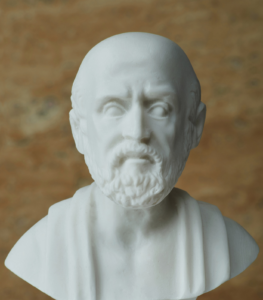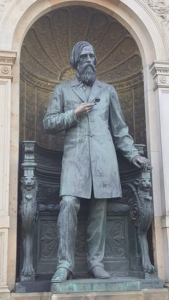The history of glaucoma management dates back thousands of years. Ancient civilizations, such as the Egyptians and Greeks, recognized the disease and attempted to treat it with various remedies. However, it wasn’t until the 19th century that significant progress was made in understanding and treating glaucoma.

First Recorded Treatments for Glaucoma Management
Some types of glaucoma were described even as early as 400 B.C.E. simultaneously by Hippokrates of ancient Greece and by Susruta of India. They described a condition that would turn the pupils bright and and slightly green, caused blindness (“dimness of vision”), and made the eye feel hard, which is exactly what happens with Angle Closure Glaucoma! Hippokrates called this condition “glaykoseis.”
The treatments prescribed were often herbal mixtures and compresses, with varying results. Modern science has found that the herb thyme does contain a compound effective at lowering eye pressure, which would have been very available in the region.

Surgical techniques (and the historical record) would languish for centuries until the 19th century.
The first recorded surgical techniques for managing glaucoma involved using a sharp instrument to create a hole in the sclera, the white part of the eye. This procedure, known as sclerotomy, was first described by the German ophthalmologist Albrecht von Graefe in 1857. Sclerotomy helped to relieve the pressure in the eye and reduce the severity of glaucoma symptoms. However, it was a risky procedure that often led to complications such as infection and bleeding.
In the late 1800s, a French ophthalmologist named Louis de Wecker developed a technique called iridectomy. This involved removing a small piece of the iris, the colored part of the eye, to create a new opening for fluid to drain out of the eye. Iridectomy was a significant advancement in glaucoma management, as it was less invasive than sclerotomy and had a lower risk of complications. It remained a popular treatment for many decades.
Hypotensive Drops and Modern Developments

In the early 20th century, the use of pilocarpine drops was discovered to reduce intraocular pressure in glaucoma patients. However, it wasn’t until the 1970s that the first modern hypotensive drops were developed, including timolol, a beta blocker that reduced pressure by decreasing fluid production in the eye.
Since then, numerous hypotensive drops have been developed, including prostaglandin analogs, alpha agonists, and carbonic anhydrase inhibitors. We now have 6 different classes of medications, all with different mechanisms of action, to use in glaucoma treatment. These drops are often used in combination to achieve optimal results.
The biggest problem with these drops is for people to remember to use them. Of people prescribed just one of these drops, about 60% will not take the drops as recommended, according to studies. When two drops are indicated, compliance drops even lower.
This can explain the newest trend of procedures that work day and night, such as Selective Laser Trabeculoplasty (a.k.a. SLT), time-release medications, or Minimally Invasive Glaucoma Surgery (a.k.a. MIGS).
Famous Names in Glaucoma Management
Throughout history, there have been several famous names associated with glaucoma management. Here are just a few:

- Alhazen (965-1039): Also known as Ibn al-Haytham, Alhazen was a Muslim scientist who is credited with the first description of full glaucoma in his book “Book of Optics.” He described the disease as “al-ma’, meaning “the water,” due to the buildup of fluid in the eye.
- Harold Ridley (1906-2001): Ridley was an English ophthalmologist who is credited with the invention of the intraocular lens, which revolutionized cataract surgery. He also contributed to the development of surgical techniques for glaucoma, including the use of trabeculectomy.
- Robert N. Weinreb (1950- ): Weinreb is an American ophthalmologist who is a leading authority on glaucoma. He has contributed to the development of numerous glaucoma diagnostic tools and treatments, and has received numerous awards for his work.
Conclusion
The history of glaucoma management is a fascinating one, marked by numerous breakthroughs and discoveries. From ancient practices to modern hypotensive drops, our understanding of glaucoma treatments has come a long way. And with ongoing research and advancements in technology, the future of glaucoma management looks promising. It is currently one of the most researched diseases of ophthalmology and new treatments are being developed as you read this!